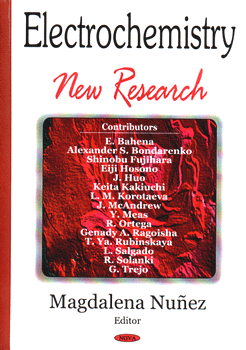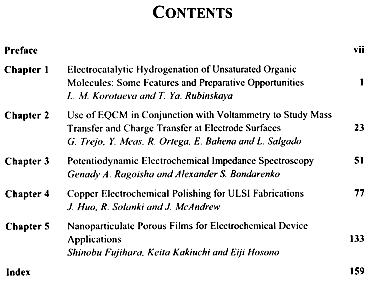Electrochemistry: New Research, M. Nunez (Ed.), Nova Science Publ., New York, 2005.
ISBN 1-59454-741-6


Chapter 3: Potentiodynamic electrochemical impedance spectroscopy. G. A. Ragoisha and A. S. Bondarenko. pp. 51-75.
AbstractPotentiodynamic Electrochemical Impedance Spectroscopy (PDEIS) acquires and analyses the integral ac and dc response of the electrochemical interface, using virtual instruments that probe the interface, by means of a common potentiostat, with streams of low-amplitude coordinated wavelets. The built-in analyser of the PDEIS spectrometer program decomposes the integral response, in real-time during the potential scan, into a cyclic voltammogram and a 3D impedance spectrum that represents frequency response variation with the electrode potential. The analysis of the 3D spectrum after the scan gives dependences of equivalent electric circuit parameters as function of the potential. Thus in a single scan a set of potentiodynamic dependences is obtained that characterises both the dc and ac potentiodynamic responses. The ac response is characterised individually for each constituent represented in the equivalent circuit. In the cyclic scan PDEIS operates as the extended variant of cyclic voltammetry that gives cyclic dc and constituent ac responses, which are especially helpful for characterising nonstationary interfaces. New opportunities that result from the PDEIS spectra analysis are illustrated by examples that represent reversible (Fe3+/Fe2+) redox system, locally reversible (Cu and Bi upd on Au in presence of different anions) and strongly irreversible systems (irreversible Ag upd on Pt and Pb on Te, electrochemically stimulated transformations in thin oxide films and aniline electropolymerisation). In the reversible electrochemical transformations of iron salts, the 3D spectra are almost identical in the cathodic and anodic scans, and their analysis gives the charge transfer resistance and Warburg constant as functions of the potential that comply with theoretical predictions for reversible reaction, while in the irreversible systems the constituent responses are different in the forward and backward scans, and the differences give much information on the dynamics of the variable interfaces. In particular, PDEIS spectra analysis of TiO2 films doped by cathodic treatment gives variable Mott-Schottky plots that provide monitoring of nonstationary doping that results from intercalation of protons.
Back to publications about potentiodynamic electrochemical impedance spectroscopy